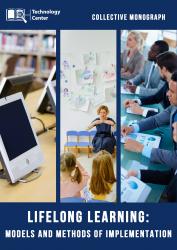Definition, classification, characteristics and opportunities of development receptivity to the new
Keywords:
maturity, organizational competence, pedagogical experiment, methods, criterion, criterionlevels, correlation, statistics, lists in physical culture and sports, adult education, concept of continuous adult education, new paradigm of, adult education development trends, megatrends in adult education, soft, niversal (ability)/theoretical (knowledge) models of education, development mechanism, regional (meso)/global (planetary) levels, interstate cooperation in fields of adult education, Scandinavian model of adult education, innovative efficiency models, foreign language communication, , lifelong learning, multiculturalism, lifelong learning, flipped classroom approach, task-based learning, immersion models, technology application, language learning resources, student-centered learning, language immersion, intercultural competencies, academic staff, development, institutional autonomy, personnel policy, university, receptivity to the new, cognitive function, regulatory function, classification features, form of knowledge of reality, leading aspects of the perceived object, dominant feelings, field of activity, components of the subject's experience, cognitive-emotional processes, environment of selected information, hierarchical level of the management entity, means of developing receptivity to the new, idea management systemAbstract
Justifying the relevance of the topic, the authors refer to the following methodological assumptions: triad fragility – stability – antifragile (Nassim Taleb); conclusions about the possibility of "the emergence of order from chaos"; alternative future development (Antonina Yevtodiuk, Ilya Prigozhin); conclusions about the presence of internal connections of a self-organized system with an external environment (Ilya Prigozhin, Hermann Haken). A multidisciplinary approach was used during the research; various scientific directions were integrated; results of theoretical scientific research and practical activities. Receptivity to the new is defined as the ability of an individual to perceive signs of the new (future) and to be guided by the formed idea (consciously or unconsciously) in its practical activities. The classification is presented according to predefined classification features within the definition of receptivity to the new: a form of knowledge of reality; leading aspects of the perceived object; dominant feelings; field of activity; components of the subject's experience; cognitive– emotional processes; environment of selected information; hierarchical level of the management entity.
Traits of a personality susceptible to new things are outlined. Identification of different types of receptivity to the new is given on the examples of autobiographical data of Alexander Fleming, Wilhelm Konrad Röntgen, Isadora Duncan, Fritz Haber, Henry Ford, Steve Jobs, historical socio-political events.
The means of developing individual and group receptivity to the new are revealed. Among the means of developing personal receptivity to the new, the following are presented: an idea creation algorithm, creative problem solving technologies, special exercises and techniques based on the principles of non-linear thinking. From the point of view of formation of team and organizational values, development of collective search and decision-making skills, importance is gained by corporate training in such modified forms as active training methods; modern management models and technologies; coaching training technologies. The issues of creating an idea management system are considered, as such, which stimulates the development of receptivity to the new within the organization, institution, institution.

LIFELONG LEARNING: MODELS AND METHODS OF IMPLEMENTATION
Downloads
Pages
Published
Categories
License

This work is licensed under a Creative Commons Attribution-NonCommercial-NoDerivatives 4.0 International License.

